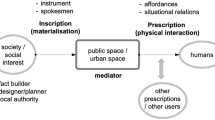Abstract
This study develops a genetic phenomenological sociology of space from the phenomenology and phenomenological sociology of space. Based on relational ontology, it argues that social space is a social relationship in genesis. An Apple walk-in store and an Apple online store are examples to illustrate the essence of social space. Any Apple store as a social space represents a set of social relations. The genetic phenomenological sociology of space in both store types includes two parts: first, the social ontology of space, that is, ‘being-in-the-Apple-store’ or ‘being-in-the-Apple-online-store’; and second, the social epistemology of space, that is, the act of ‘encountering’ in either store. Examining the existence of space ontologically and the mode of existence epistemologically clarifies that the actual ‘meaning’ of social space, an Apple store or an Apple online store in this study, emerges through the act of encountering. Three characteristics of encountering are placelessness, ‘de-distancing,’ and mediation.
Similar content being viewed by others
Notes
This translation is based on work by Gu Zhengkun (1995: 87). Original Chinese text is as follow:

Most importantly, Dao De Jing has no punctuation marks, leading to varied interpretations by different scholars. As indicated by black italics in the Chinese text above, a comma is usually put after the nothingness (

), but I put it after the being (substance,

). I arranged the punctuation marks and interpreted the text the way that I believe follows the philosophical meaning of Dao De Jing in the vision of Guodianchujian (

) and is in accord with phenomenological ontology.
References
Ash, J., & Simpson, P. (2016). Geography and post-phenomenology. Progress in Human Geography, 40(1), 48–66.
Benjamin, W. (1999). The Arcades Project. Cambridge, MA: Belknap Press.
Casey, E. (1997). The fate of place: A philosophical history. Berkeley, CA: University of California Press.
Castells, M. (1977). The urban question: A Marxist approach. London: Edward Arnold.
Castells, M. (2000). The rise of Network Society. Oxford, MA: Blackwell.
Castoriadis, C. (1987). The Imaginary Institution of Society. Cambridge, Mass.: MIT Press.
Chan, J., Pun, N. (2010). Suicide as protest for the new generation of Chinese migrant workers: Foxconn, global capital, and the state. The Asia-Pacific Journal, 8 (37.2).
Cresswell, T. (2004). Place: A short introduction. Malden, MA: Blackwell.
de Certeau, M. (1984). The practice of everyday life. Berkeley, CA: University of California Press.
Debord, G. (1995). The society of the spectacle. New York, NY: Zone Books.
Foucault, M. (1979). Discipline and punish: The birth of the prison. New York, NY: Vintage Books.
Foucault, M. (2002). The order of things: An archaeology of the human sciences. London; New York, NY: Routledge.
Gadamer, H. (2004). Truth and method. New York, NY: Crossroad.
Gu Zhengkun (Translator). (1995). Lao Zi: The book of Tao and Teh. Beijing: Peking University Press.
Harvey, D. (2000). Spaces of hope. Edinburgh: Edinburgh University Press.
Harvey, D. (2009). Social justice and the city. Athens: University of Georgia Press.
Heidegger, M. (1971). Poetry, language, thought. New York, NY: Harper & Row.
Heidegger, M. (2000). Pathmarks (Lubiao) (Sun Zhouxing, trans.). Beijing: Commercial Press.
Heidegger, M. (2010). Being and Time. Trans. Joan Stambaugh. Albany, NY: State University of New York Press.
Husserl, E. (2001[1900,1901]). Logical Investigations, Volume1, Volume 2. London; New York, NY: Routledge.
Kinkaid, E. (2020). Re-encountering Lefebvre: toward a critical phenomenology of social space. Environment and Planning D: Society and Space, 38(1), 167–186.
Lagerkvist, A. (2017). Existential media: toward a theorization of digital thrownness. New Media & Society, 19(1), 96–110.
Lefebvre, H. (1991a). Critique of everyday life. New York, NY: Verso.
Lefebvre, H. (1991b). The Production of space. Cambridge, USA: Blackwell.
Meyrowitz, J. (1985). No sense of place: The impact of electronic media on social behavior. New York, NY: Oxford University Press.
Peters, J. (2015). The marvelous cloud: Marvelous clouds: Toward a philosophy of elemental media. Chicago, IL: University of Chicago Press.
Pun, N., & Chan, J. (2012). Global capital, the state, and Chinese workers: the Foxconn experience. Modern China, 38(4), 383–410.
Pun, N., Shen, Y., Guo, Y., Lu, H., Chan, J., & Selden, M. (2016). Apple, Foxconn, and Chinese workers’ struggles from a global labor perspective. Inter-Asia Cultural Studies, 17(2), 166–185.
Qiu, J. (2016). Goodbye iSlave: A manifesto for digital abolition. Champaign: University of Illinois Press.
Relph, E. (1976). Place and placelessness. London: Pion.
Schutz, A. (1967). The Phenomenology of the social world. Evanston, IL: Northwestern University Press.
Soja, E. (1996). Third space: Journeys to Los Angeles and other real-and-imagined places. Cambridge, MA: Blackwell.
Soja, E. (2010). Seeking spatial justice. Minneapolis, MN: University of Minnesota Press.
Tilley, C. (1994). A phenomenology of landscape: Places, paths and monuments. Oxford, UK: Berg Publishers.
Tuan, Y. (1977). Space and place: the perspective of experience. Minneapolis, MN: University of Minnesota Press.
Wang, Q. (2004). Heidegger and a hermeneutical interpretation of Confucianism and Daoism. Beijing: China Renmin University Press.
Wheeler, M. (2011). Martin Heidegger. In Stanford Encyclopedia of Philosophy. https://plato.stanford.edu/entries/heidegger/?source=your_stories_page.
Author information
Authors and Affiliations
Corresponding author
Additional information
Publisher's Note
Springer Nature remains neutral with regard to jurisdictional claims in published maps and institutional affiliations.
Rights and permissions
About this article
Cite this article
Zhang, V.Q. Being-in-the-Apple-store: a genetic phenomenological sociology of space. Hum Stud 43, 667–682 (2020). https://doi.org/10.1007/s10746-020-09559-y
Accepted:
Published:
Issue Date:
DOI: https://doi.org/10.1007/s10746-020-09559-y








